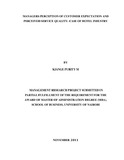| dc.description.abstract | During the past decades, service sector has been known as an important player in the world economy. Considering the significant role of services in the hospitality industry, this research assesses the service quality gaps based on customer expectations and managers perceptions in a five-star hotels in Nairobi. For this purpose, service quality gaps have been measured and studied through analysis based on a comprehensive set of service quality dimensions. Five star hotels mainly owned by private stakeholders in Kenya playa vital role in the development of hotel and Tourism industry hence requires high level of operational service quality is expected.
The researcher examined the SERVQUAL model as developed by Parasuraman, Zeithaml and Berry in 1985 (Figure 3, page 17). The conceptual framework they developed helped to elucidate the various gaps that can exist in the service delivery process. GAP I, which is the gap between management's perception and expected service quality, was the main theme of interest in this research as detailed in dimensions of services (Figure I, page 1l).This gap results when there is a discrepancy between what management perceives to be the customers' expectations and the actual established service quality specifications.
The research was conducted by collection of primary data from Managers and customers of 5 Star Hotels in Nairobi as per (Appendix 1) using a survey research design. A convenient sample size of 40 managers and 80 guests was considered. A questionnaire based on service dimensions framed into questions ona five-point Likert scale was used to collect data, from which findings were made.
Data analysis using descriptive statistics that involved use of frequency tables, mean and standard deviation were used. The SERVQUAL model was used to analyze customer expectations, their perceptions on the quality of service and the gap between the managers' and customers' perception of the service quality. It was established that managers have a good idea of what customers expect in terms of service quality, however, this study established that there are gaps in service delivery. The largest gap emerged in the empathy dimension which had the highest overall service gap score of - 0.83 and the highest standard deviation overall score of 0.1585.
From the findings it is evident that the manager's perception of service quality dimensions is not matching to the customer expectations. In all the dimensions, managers have fallen short of the customer's expectation by a mean range of -0.29 to -0.83 and with a standard deviation range of -0.0059 to 0.1585. Therefore the findings suggest that guests have generally a high expectation on the quality of service that they receive. | en_US |

